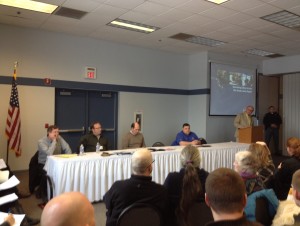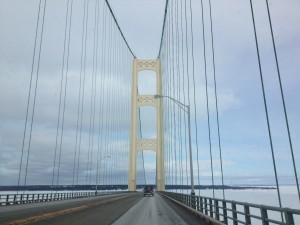
Above: Hundreds of people attend a public comment session held by the U.S. Army Corps of Engineers on the oil pipeline tunnel proposed by Enbridge under the Straits of Mackinac, on Sept. 8, 2022, at Little Bear East Arena in St. Ignace, Michigan. Photos by Kelly Thayer.
By Kelly Thayer, FLOW Deputy Director

Katie Otanez, Regulatory Project Manager for the U.S. Army Corps of Engineers, Detroit District, delivers a presentation on Sept. 8, 2022, in St. Ignace, Mich., while Army Corps staff look on.
Five-and-half hours into a marathon federal hearing that lasted seven hours on Thursday, September 8, in St. Ignace, Michigan, more than 4 out of 5 people who spoke said that an oil pipeline tunnel proposed under the Great Lakes was a dangerous idea that would rob future generations by threatening the most precious thing on earth — fresh water — and worsening the climate crisis.
The U.S. Army Corps of Engineers held the public comment session to help set the scope of its environmental impact statement study of a proposal by Enbridge, Inc., of Canada, to build an oil tunnel under the Straits of Mackinac to house its Line 5 oil pipeline, which carries oil from western Canada primarily to refineries in Sarnia, Ontario. The Army Corps study is expected to continue through at least 2023.

U.S. Army Corps welcome sign on Sept. 8, 2022, in St. Ignace, Mich.
Hundreds of people attended the meeting at Little Bear East Arena, a local hockey facility just north of the Mackinac Bridge in the eastern Upper Peninsula, with each commenter taking up to three minutes to address the Army Corps staff seated up front. Most people expressed deep concern for the harm that construction or a potential explosion or spill from the operation of an oil pipeline tunnel could have on their children and grandchildren’s future, local residents, the Great Lakes, drinking water, tourist economy, and jobs — as well as tribal rights, tribal member survival, cultural heritage, the fishery, ecology of the Straits of Mackinac, and the climate.
Whitney Gravelle, president of the Bay Mills Indian Community, was the first to speak at the Army Corps meeting against the tunnel proposal and sought to change the narrative promoted by Enbridge in its multimillion-dollar advertising campaign. “Line 5 is not about Enbridge. It is not about jobs. It is not about profit. It is about the continued existence of my people here in the State of Michigan.”

Whitney Gravelle, President of the Bay Mills Indian Community
“Line 5 is not about Enbridge. It is not about jobs. It is not about profit. It is about the continued existence of my people here in the State of Michigan.” — Whitney Gravelle, president of the Bay Mills Indian Community
“We rely on all of those natural resources to be able to live, to be able to support our families and just exist as Anishinaabe people,” said President Gravelle, emphasizing that more than half of Bay Mills tribe members depend on their treaty rights to hunt, fish, and gather for subsistence.

Ian Bund, venture capitalist
Ian Bund, a venture capital investor who attended the hearing on his birthday to oppose the tunnel project, said, “There’s no evidence that Enbridge’s board of directors has approved the tunnel. Is it a PR stunt? Enbridge is largely uninsured, uninsurable, and un-bondable…. There’s no evidence how Enbridge would finance the tunnel project. One wonders if they might look to taxpayers.”
Enbridge, in fact, lacks adequate liability insurance, according to a report released by the Attorney General Dana Nessel’s office revealing that Enbridge’s subsidiaries, not its parent company, hold Line 5’s 1953 easement and signed the proposed tunnel agreement; the assets of the subsidiaries’ parent Enbridge are inadequate to cover the costs and economic damages in the event of a moderate spill.
Many Troubling Aspects of the Tunnel Proposal

Enbridge wants to blast and bore an oil tunnel under the Straits of Mackinac just west of the Mackinac Bridge. Credit: Flickr
Enbridge is proposing to bore and blast a 20-foot-in-diameter tunnel under the Straits of Mackinac to house a new Line 5 pipeline. The Canadian company’s goal is to continue for another 99 years carrying up to 23 million gallons of oil and natural gas liquids a day through Line 5 and State of Michigan public trust bottomlands where Lake Michigan meets Lake Huron, just west of the Mackinac Bridge.
FLOW and our partners have identified critical deficiencies in the project’s construction permit application, its legal authorization, and the review by State of Michigan environmental agencies of expected impacts to wetlands, bottomlands, and surface water, including from the daily discharge of millions of gallons of wastewater during construction. FLOW has expressed continuing concerns about the impact to the Great Lakes and lack of public necessity for the project, which would worsen climate change by adding greenhouse gas emissions each year equivalent to almost seven new coal-fired power plants or nearly 6 million new cars to the road, according to experts.
FLOW’s position, as expressed at the hearing in St. Ignace, is that the Army Corps’ environmental study of the tunnel proposal and alternatives must include, at a minimum:
- A no action alternative that would use existing capacity in other pipelines and, if necessary, other transportations solutions–such as rail and truck transport of natural gas liquids–in lieu of building new pipeline infrastructure.
- An alternative to connect Enbridge’s Superior, Wisc., and Sarnia, Ontario, terminals without crossing the Great Lakes. (See FLOW’s fact sheet on alternatives).
- A tunnel alternative that fully eliminates the risk of oil intrusion into the Straits in the event of an explosion or similar event.
Tribal Nations, agencies, communities, organizations, citizens, and other stakeholders can comment on the tunnel proposal through Oct. 14, 2022, via mail, through the Army Corps project website, or at the Army Corps’ Oct. 6, 2022, online meeting. The Oil & Water Don’t Mix campaign, of which FLOW is a founding steering committee member, also is collecting and forwarding comments to the Army Corps using an email template that suggests key points to make.
Oil & Water Don’t Mix Campaign Mobilizes Great Lakes Advocates
The Oil & Water Don’t Mix campaign chartered two buses that gathered people in Ann Arbor, East Lansing, and Traverse City to attend the Army Corps’ September 8  meeting, with FLOW, the Sierra Club Michigan Chapter, and several other allied groups helping organize the effort. Many riders wore the campaign’s black t-shirts with white letters proclaiming “No Line 5 Oil Tunnel.” At the session, Enbridge and some allied trade unions also wore bright blue or orange shirts expressing support for the proposed tunnel or labor to show their solidarity.
meeting, with FLOW, the Sierra Club Michigan Chapter, and several other allied groups helping organize the effort. Many riders wore the campaign’s black t-shirts with white letters proclaiming “No Line 5 Oil Tunnel.” At the session, Enbridge and some allied trade unions also wore bright blue or orange shirts expressing support for the proposed tunnel or labor to show their solidarity.

Kim Gribi of Traverse City

Lana Pollack, former U.S. Chair of the International Joint Commission
Several people, including Lana Pollack, former U.S. chair of the International Joint Commission, called Enbridge a “bad actor” with a long history of oil spills from Line 5, which runs through the Straits, and Line 6B in southern Michigan that burst in 2010 into the Kalamazoo River watershed.
Kim Gribi, a concerned citizen from Traverse City, also pointed to Enbridge’s “bad track record.” Gribi said that with her professional background in human resources and evaluating applicants for jobs, when it comes to the tunnel project and Enbridge, “I wouldn’t hire them.”

Barbara Stamiris of the Northern MI Environmental Action Council
Barbara Stamiris of the Northern Michigan Environmental Action Council and others questioned whether the tunnel proposal was a delay tactic by Enbridge to allow the Canadian energy-transport giant to keep running its Line 5 oil pipelines indefinitely in the open waters of the Straits of Mackinac, despite a standing order issued in November 2020 by Gov. Gretchen Whitmer to shut down the risky 69-year-old pipeline segment.
A number of people in their public remarks in St. Ignace requested that the Army Corps extend the 60-day comment period on the proposed tunnel and hold additional in-person meetings downstate to reach more people on such a critical matter as the future of the Great Lakes and the drinking water supply.
FLOW: There’s No Alternative to Fresh Water
FLOW Board member Barbara Brown, a St. Ignace resident who served for 14 years on the Mackinac Bridge Authority, pointed to what the region must protect above all else: our freshwater heritage. “We are rapidly moving toward alternative forms of energy. Enbridge already has, in Line 78 [in southern Michigan], an alternative route of delivery… What we do not have is an alternative to water.”

FLOW Board Member Barbara Brown, a resident of St. Ignace, Mich., addresses the Army Corps staff.
“We are rapidly moving toward alternative forms of energy. Enbridge already has an alternative route of delivery… What we do not have is an alternative to water,” said Barbara Brown, FLOW Board Member and St. Ignace resident
In fact, the North American energy pipeline system operated by Enbridge and its competitors has available capacity and flexibility to meet energy demand in the Great Lakes region without threatening public waters and the economy, according to multiple studies. One of Enbridge’s own experts has concluded gasoline prices will rise by about only half a penny in Michigan if the Line 5 oil pipeline shuts down.
“We are sitting today at the very heart of 20% of the world’s fresh surface water,” Brown said. “With much of humanity and the animal world on the brink of death for want of water, and we being at the center of the largest body of fresh surface water on the planet, it is bordering on the immoral to even entertain the unnecessary, continued operation of Line 5 through the Great Lakes whether by pipe or tunnel.”
As FLOW’s Deputy Director, I (the author of this article) helped coordinate the bus from Traverse City and in my comments, said, “The Straits of Mackinac is the worst possible place to build and operate an oil pipeline tunnel. Any rupture, explosion, or other event resulting in a major oil spill in the Straits would contaminate the very heart of the Great Lakes, which hold 95% of the fresh surface water in the United States.”
As a result, “the Army Corps’ Environmental Impact Statement or ‘EIS’ review of the project should be scoped to eliminate the risk of a pipeline-related oil spill into the Great Lakes.” (Click to read Kelly Thayer’s full comment delivered on behalf of FLOW).
Regional and Binational Perspectives

Beth Wallace of the National Wildlife Federation

Michelle Woodhouse of Environmental Defence in Canada
Michelle Woodhouse, representing Environmental Defence Canada, came from Toronto to convey that many Canadians want to move rapidly away from oil extraction as a key driver of the economy in order to cope with the “climate emergency.” Woodhouse also pointed to indigenous cultural artifacts in the Straits of Mackinac that could be damaged by the tunnel proposal and said “clear alternatives exists” that would not harm the Great Lakes.
Beth Wallace of the National Wildlife Federation, Great Lakes Regional Center, spoke next and emphasized that Enbridge’s history of nearly three dozen oil spills from Line 5 and the 2010 oil spill disaster from Line 6B in Marshall, Michigan, are forewarnings of what could happen in the Straits of Mackinac.
Maya Ponton Aronoff pointed to better ways for Enbridge and trade workers to aid the residents of Michigan than building an oil pipeline tunnel under the Great Lakes.
“[Enbridge] could be replacing every lead-lined water pipe in Michigan that’s poisoning our children and our communities. They could be investing in renewable energy, creating jobs in solar and wind. They could be doing anything with their billions of dollars. But they’re making us believe this lie that we have to choose between jobs and our future,” said Maya Ponton Aronoff
“[Enbridge] could be replacing every lead-lined water pipe in Michigan that’s poisoning our children and our communities,” Ponton Aronoff said. “They could be investing in renewable energy, creating jobs in solar and wind. They could be doing anything with their billions of dollars. But they’re making us believe this lie that we have to choose between jobs and our future.”
Army Corps Process to Continue through at Least 2023
Enbridge’s has applied for a Army Corps permit under the Rivers and Harbors Act of 1899 and the Clean Water Act, seeking federal approval to discharge dredged or fill materials into waters of the United States, as well as the construction of structures or work that may affect navigable waters. The Army Corps also will conduct an ethnographic/traditional cultural landscape study as part of the environmental impact statement under the National Historic Preservation Act. After considering public comment and issuing the draft EIS likely by fall 2023, the Army Corps will seek additional public feedback, release a final study, and then issue a “record of decision” regarding whether to issue, issue with modification, or deny the Department of the Army permit altogether — consistent with the National Environmental Policy Act.
The Army Corps, Detroit District, to date has identified general concerns in the following categories:
- Potential direct effects to waters of the United States including wetlands; water and sediment quality; aquatic species and fisheries; threatened and endangered species;
- Archaeological and cultural resources, including the Straits as a Traditional Cultural Landscape; Tribal treaty rights and interests;
- Recreation and recreational resources; waste management; aesthetics; noise; air quality; climate change, including greenhouse gas emissions and the social cost of greenhouse gases;
- Public health and safety during construction and operations; navigation; erosion; invasive species; energy needs; environmental justice; needs and welfare of the people; and cumulative effects.
FLOW’s legal team aided in this effort in December 2020 by submitting comprehensive comments to the U.S. Army Corps of Engineers calling for an environmental impact statement on behalf of a dozen organizations: Chippewa Ottawa Resource Authority, Clean Water Action—Michigan, FLOW, Groundwork Center, League of Women Voters of Michigan, Michigan Environmental Council, Michigan League of Conservation Voters, NMEAC, Sierra Club Michigan Chapter, Straits Area Concerned Citizens for Peace, Justice and Environment, Straits of Mackinac Alliance, and TC 350. The comments demonstrated a serious gap in Enbridge’s evaluation of the presence of loose, unconsolidated rock and sediment in the bottom of the Straits of Mackinac that Enbridge has characterized as solid bedrock.
Learn more about FLOW’s efforts to shut down Line 5 and stop the proposed oil pipeline tunnel on FLOW’s Line 5 program page and new Line 5 fact sheet.


 regional fossil-fuel energy demands, which are forecasted to dwindle in the ongoing transition to clean energy, while maximizing protection of the Great Lakes and combating climate change.
regional fossil-fuel energy demands, which are forecasted to dwindle in the ongoing transition to clean energy, while maximizing protection of the Great Lakes and combating climate change.



 In addition to the Oct. 6 meeting, the public can comment on the study of the tunnel proposal by October 14 by mail or the Army Corps
In addition to the Oct. 6 meeting, the public can comment on the study of the tunnel proposal by October 14 by mail or the Army Corps Canadian company’s stated goal is to continue for another 99 years carrying up to 23 million gallons of oil and natural gas liquids a day through Line 5 and State of Michigan public trust bottomlands where Lake Michigan meets Lake Huron, just west of the Mackinac Bridge.
Canadian company’s stated goal is to continue for another 99 years carrying up to 23 million gallons of oil and natural gas liquids a day through Line 5 and State of Michigan public trust bottomlands where Lake Michigan meets Lake Huron, just west of the Mackinac Bridge.
























